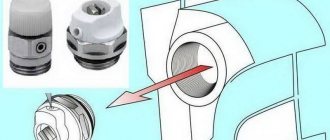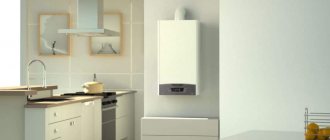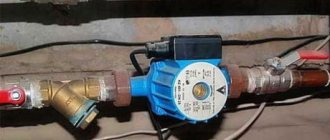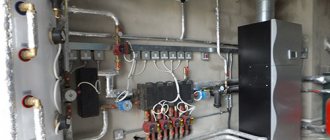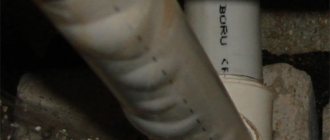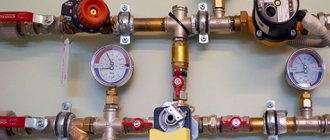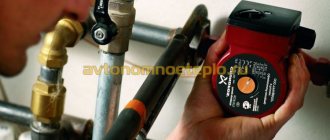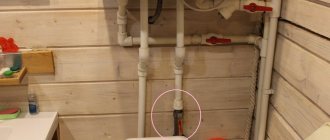How circulation pumps are designed and work
The operating principle of circulation pumps is not much different from the design of drainage models. The device body is made of durable materials that are resistant to corrosion. Typically this is stainless steel, aluminum, brass, cast iron. When started, the engine begins to rotate a rotor equipped with an impeller. As a result, the pressure at the inlet pipe decreases and water is sucked into the hydraulic chamber. The rotation of the impeller creates centrifugal force. Water is pressed against the walls of the chamber and forcefully thrown into the pipeline through the outlet. This ensures forced circulation of the coolant in a closed heating circuit.
Design differences between different types of devices
There are two main types of pumps - with “wet” and “dry” rotors. The “wet” rotor is separated from the water by special sealing rings, between which there is a thin film of water. When worn, the rings wear out and are pressed closer to each other, which guarantees the tightness of the structure for several years. Cooling and lubrication are provided by the working fluid. Pumping equipment of this type is installed in systems with small coolant volumes, because It is difficult to ensure tight connections in large-diameter structures
When installing devices, it is important to ensure that the shaft is positioned strictly horizontally, otherwise the device may malfunction
The main advantage of “dry” models is their high efficiency. It is 80%, which distinguishes it favorably from the 50% efficiency of “wet” type devices. The rotors of “dry” heating circulation pumps do not come into contact with the liquid. Depending on the location of the engine, structures are divided into horizontal (cantilever), vertical and block. All “dry” models are noisy during operation and are sensitive to the quality of the coolant and air purity. It is advisable to install them in separate rooms of boiler rooms, controlling the purity of the water in the system and the air in the room.
source
Rules for operating circulation pumps
The circulation pump can last long enough only if the following series of rules are observed:
- The pump can only be started if the system is filled with coolant;
- The pump should not operate when there is no supply;
- The volume of pumped liquid must correspond to the range that the pump is able to process, otherwise the equipment will wear out too quickly (you can find out the required value in the technical documentation for the pump);
- To prevent the pump from being subjected to oxidation during the warm season, you need to run the heating system for 20 minutes at least once a month;
- The temperature of the liquid pumped by the pump should not be higher than 65 degrees - exceeding this level will lead to the precipitation of solid salts.
There are two types of pumps on the market - “dry” and “wet”. The classification depends on whether there is direct contact between the rotor of the device and the pumped medium. For dry pumps, high noise levels are common. The thing is that such devices are equipped with a fan, which makes a lot of noise during operation, so such equipment is not used in private homes.
Of course, sometimes developers make a mistake (sometimes deliberately, sometimes not) and install a pump with a dry rotor in a private house. Typically, the main argument of such developers is the high efficiency of such equipment - and they prefer to remain silent about the main drawback, which is that the heating pump makes too much noise. In this case, the only way to solve the noise problem is by high-quality sound insulation of the room, or by replacing the pump with a more suitable one.
In wet pumps, the rotor is constantly located inside the pumped medium, which also ensures cooling of the working elements of the equipment. There is no fan in these devices, so they do not make noise during operation, and they can be safely installed in residential buildings.
You can first guess about some problems with pumping equipment by the various sounds that it begins to make. If the heating circulation pump is noisy, you need to figure out what exactly the problem is and try to fix it.
Why does the heating pump get hot?
When installing a closed-type heating system, a circulation pump is installed on the pipeline. The main task of this device is considered to be pumping coolant, water or antifreeze, which ensures quick and uniform heating of all living areas of a dacha, cottage or any other country house. Thanks to the pump and boiler automation, the user can set the optimal temperature in his home, but sometimes such a device overheats and cannot perform its assigned tasks efficiently. In our article we will get acquainted with the reasons for this phenomenon and methods for solving such a problem.
Possible breakdowns and ways to eliminate them
troubleshoot the problem as necessary. By the way, it is recommended to protect the pump from surges in the network by installing a reliable stabilizer. This move will also protect the pump from the burning of a fuse, which fails as a result of constant pressure drops in the network
So, if something goes wrong with your circulation pump and it refuses to work, then we’ll try to repair the unit ourselves.
Important: but if you are not confident in your abilities or do not have the appropriate tool at hand, then it is better to contact a specialized center
If the pump makes a hum, but the impeller does not rotate
The reasons may be the following:
- Presence of a foreign object in the impeller area;
- The rotor shaft has oxidized due to long-term downtime of the unit;
- Loss of power supply to the mechanism terminals.
In the first case, you need to carefully remove the pump from the heating system and unscrew the housing in the area of the impeller. If a foreign object is found, remove it and rotate the shaft by hand. When assembling the pump in the reverse order, it is necessary to install a reliable filter on the pipe.
If there is oxidation, then clean it well, lubricate all movable elements of the working unit and reassemble the pump in the reverse order.
If there is a problem with the quality of the power supply, then you will have to check the voltage using a tester. First, completely replace the cable in all sections of the cable and if a break or fault is detected. Then, if the cable is OK, check the voltage at the terminals. If the tester shows infinity, a short circuit has occurred. If it shows less voltage, it means that the winding has broken. In both cases, the terminals are replaced.
If the unit shows no signs of life at all
This can happen if there is no voltage in the network. Using a tester, check the voltage and, if necessary, correct the problem.
By the way, it is recommended to protect the pump from surges in the network by installing a reliable stabilizer. This move will also protect the pump from the combustion of a fuse, which fails as a result of constant pressure drops in the network.
If the pump starts but then stops
The reasons may be:
- Presence of scale between the moving elements of the unit;
- Incorrect pump connection at the terminals.
In the first case, you will have to disassemble the pump and check it for scale. If detected, limescale deposits are removed and all joints between the rotor and stator are lubricated.
If there is no scale, then check the tightness of the fuse on the unit. You should remove it and thoroughly clean all the clamps. Here it is also worth checking that all wires in the terminal box are connected correctly in phases.
If the pump makes a loud noise when turned on
The reason for this is the presence of air in a closed circuit. It is necessary to release all air masses from the pipes, and install a special unit in the upper part of the pipeline to prevent the formation of air locks.
Another reason could be wear on the impeller bearing. In this case, you need to disassemble the unit housing, check the bearing and, if necessary, replace it.
If the pump is noisy and vibrates
Most likely, the issue is insufficient pressure in the system. It is necessary to add water to the pipes or increase the pressure in the area of the pump inlet.
If the pressure is still low
Here it is worth checking the direction of rotation of the working unit in the pump body. If the wheel does not spin correctly, then an error was probably made when connecting the device to the terminals in phases when using a three-phase network.
Another reason for a decrease in pressure may be too high a viscosity of the coolant. Here the impeller experiences a lot of resistance and does not cope with the assigned tasks. You will have to check the condition of the mesh filter and clean it if necessary. It would also be useful to check the cross-section of the inlet and outlet pipes and, if necessary, set the correct operating parameters of the pump.
Common breakdowns
There are several other common reasons why the pump works but does not pump water - these are:
- A decrease in the natural water level due to seasonal changes or improper well construction.
- Increased pump performance.
- Insufficient power of the unit in terms of head height.
- Voltage drop in the network.
- Clogging of pipelines, filter units and fittings.
- Depressurization of the main line.
- Breakdown of pumping mechanisms.
If the pump works but does not pump water, the reasons may also be hidden in the breakdown of its critical mechanical parts. The situation can be corrected either by repair or installation of a new unit.
Important! To ensure uninterrupted operation of an autonomous source, pumping equipment must be correctly selected according to the height of the flow being lifted. In this case, the calculation takes into account not only vertical, but also horizontal sections. As a rule, a lying section of pipe of 5 meters is equivalent to a 1-meter segment located standing.
Unit features
The principle of operation of circulation pumping equipment is based on creating continuous circulation of liquid in the system without changing the pressure indicator
A circulation pump is a device that operates in a closed heating system and moves water in a pipeline. The unit maintains a certain temperature of the coolant in the system. The device does not replenish coolant losses and does not refill the system. The system is filled using a special pump or a certain pressure in the pipes.
The principle of operation of circulation pumping equipment is based on creating continuous circulation of liquid in the system without changing the pressure indicator. Since after installation the device operates constantly, the main requirements for such pumps are low noise level during operation, economical energy consumption, reliability, durability and ease of use.
Important: circulation pumps are compact devices that do not take up much space and do not create noise during operation. The scope of use of circulation units for heating systems is quite extensive.
They are installed:
The scope of use of circulation units for heating systems is quite extensive. They are installed:
- in traditional radiator systems;
- when installing a water heated floor;
- in geothermal systems;
- when organizing hot water supply for cottages and dachas.
Unlike forced circulation systems, this pumping equipment does not require pipes with an increased diameter. In addition, the device has the following advantages:
- speed of heating the room;
- the boiler can be installed in any suitable place;
- coolant losses and air pockets are minimized;
- The thermal relay ensures automatic control of temperature conditions;
- Electricity costs are reduced due to the use of automatic rotor speed control;
- Since liquid is constantly supplied to heating devices, their service life is extended.
Algorithm for further actions
Sometimes, even after completely cleaning the borehole channel, the watercourse is not restored. In this case, there are several reasons why the pump does not pump water:
- The mechanics of the equipment were damaged.
- There have been disturbances in the electrical circuit.
- There was a depressurization of the central pipeline.
- The control system has broken down.
Checking the pumping station Source sovet-ingenera.com
To identify the malfunction, the pump is again removed from the well channel and immersed in a barrel filled to the brim. Next, the engine is started and diagnostics are carried out. There are three possible scenarios:
- The motor has started and is working properly - therefore, there are no breakdowns in the electrical circuit.
- The engine does not turn on - disassembly and electrical repair is required.
- The pump is operating, but the outlet pressure does not reach operating levels.
Low pressure when the unit is running may indicate breakdowns in the line. If it is not possible to visually establish their location, then plugging the flow outlet, for example, with the hand of a hose, will provoke a sharp increase in pressure in the pipe and the formation of water streams in places of leakage.
Advice! Repairing a broken hose operating under pressure is unreliable. Because under the influence of pressure, both the patches and the glued areas will constantly break through and lead to even greater leakage. It is better to immediately replace it with a new one.
Replacing the main hose Source ytimg.com
Reasons why the circulation pump is noisy
The main condition for long-term and trouble-free operation of the device is proper installation, carried out in strict compliance with the manufacturer’s recommendations.
If the circulation pump is humming, you should make sure that all installation operations were carried out without violations. To prevent this problem from occurring, experts recommend installing a pressure membrane tank (hydraulic compensator). With its help you can control the static pressure in the system. A membrane tank will eliminate cavitation loads, which not only contribute to the creation of hum, but also negatively affect the service life of the device.
In order to create comfortable conditions for living in the house, you should choose the right location for installing the pump. It should be determined by the design features of the equipment
Particular attention should be paid to purifying the water used in the system. Many people are wondering why the circulation pump is humming at the beginning of the heating season? As a rule, this happens due to the fact that when the communications are filled with system liquid, air enters the heat-conducting pipes and the body of the pumping device
Air pockets can be removed through special holes equipped with screw plugs
Many people are wondering why the circulation pump is humming at the beginning of the heating season? As a rule, this happens due to the fact that when the communications are filled with system liquid, air enters the heat-conducting pipes and the body of the pumping device. Air pockets can be removed through special holes equipped with screw plugs
Valves for removing air from the system should be located at the highest points of the heating system elements. Before each start of the system, make sure that there is no air in the system. Modern models of circulation pumps, due to their design features, do not require maintenance. Dirt accumulated during the summer period of inactivity can be removed by turning on the booster motor at maximum power.
Circulation pumps with automatic adjustment during operation do not create noise in the thermostatic pipeline valves. They quickly respond to the slightest changes in the heating system. For example, when a thermostatic valve opens or closes, the device automatically changes its technical characteristics without consuming excess electricity. Electronically controlled devices do not require manual deflation.
The circulation pump can also hum as a result of mechanical failure. It can be eliminated only after installing and disassembling the device. As a result of long-term operation of equipment, technological gaps increase. The problem can be solved by replacing the adjusting washers. This measure will prevent axial runout of the motor shaft.
Also, the cause of loud operation of the pump can be wear of the working surfaces and shaft bushings. In this case, it will be necessary to replace parts that have become faulty, while simultaneously grooving the shaft. This will help prevent radial runout of the units.
The causes of cyclic noise in the circulation pump are burning of the motor windings or interturn breaks. Such breakdowns can be repaired by specialists who repair electric motors and have professional skills and the right set of tools.
What to do to stop noise from appearing
In order to prevent the occurrence of strong noise in heating equipment, it is necessary to take into account the main points when designing:
- Modern equipment for regulating flow speed is quite powerful. Even a small wet unit with a low noise level can sufficiently provide comfort in a building with a small area.
- Correct installation, which was carried out according to the manufacturer's instructions, can greatly improve the performance of the pump. During installation, it is important to remember that the power unit of models with a “wet” rotor can only be installed horizontally. If you choose a different installation method, problems may occur.
- To prevent extrusion and damage to small parts inside the pump, it is advisable to attach a filtration device with a deep cleaning function in the area in front of the pump.
- If the parameters may change, or there is no exact data on the dimensions of the room, the best choice would be models with possible changes in operating modes.
- The liquid entering the pump should not exceed a temperature of 65 degrees. Therefore, the pump must be installed on the return part of the pipeline.
Actions for prevention
In operating condition, monitor the engine heating level. If it seems too high to you, then it is better to remove the pump and contact the point of sale with a request to replace the unit. The same can be done in case of pressure mismatch
Also, to protect pumping equipment from sudden failure, it is recommended to carry out preventive maintenance of the unit, which will include the following actions:
- Regular external inspection of the pump housing and careful listening during operation. This way you can check the functionality of the pump and the tightness of the housing.
- Make sure that all external pump fasteners are properly lubricated. This will make it easier to disassemble the pump if repairs are necessary.
- It is also worth following some rules when installing a pumping unit for the first time. This will help avoid repair work in the future:
- So, when you first connect the pump to the heating network, you should turn on the unit only if there is water in the system. Moreover, its actual volume must correspond to that indicated in the technical passport.
- It is also worth checking the coolant pressure in the closed circuit here. It must also correspond to what is stated in the technical specifications of the unit.
- In operating condition, monitor the engine heating level. If it seems too high to you, then it is better to remove the pump and contact the point of sale with a request to replace the unit. The same can be done in case of pressure mismatch.
- Also, make sure that there is a ground connection between the pump and the terminals when connecting the pump. Here in the terminal box, check that there is no moisture and that all wiring is securely fixed.
- A working pump should not produce even minimal leaks. The connection points between the inlet and outlet pipes of the heating system and the pump housing deserve special attention.
Best answers
Marat Musin:
LOOK AT THE PASSPORT WHAT LIQUID SHOULD BE FILLED
******:
It looks like it runs dry or there is no water flow through it.
Vladimir Petrov:
Check the system; it looks like your water is simply flowing poorly into the new branch or not at all. And you cleaned the filter, maybe that's the problem. Or on a new branch of a pipe of small diameter. And also check that you have installed it correctly, there is an arrow in the direction of the water
Viktorij Lashhehova:
❝Actually, what could be the problem? ❞If there were financial disagreements when paying with the contractor, then you need to resolve them and then everything will work correctly for you.
Stubborn Like Dac:
It appears that the pump rotor is not turning. At the end of the pump there is a plug with a slot for a screwdriver. Unscrew this plug and tap on the rotor axis with a metal object (for example, the same screwdriver) ... I had a similar situation last year and after several light blows with a screwdriver, the pump started working and is still working.
The device is so hot that a boiler is not needed. Why does the pump in the home heating system get hot?
Improper operation of the circulation pump leads to various problems, including overheating.
Due to overheating, pumping equipment may fail, which will lead to the stoppage of the entire heating system. This is especially dangerous in winter.
ontakte
Odnoklassniki
The purpose of installing such a device is to pump fluids in the heating system and create pressure. These processes help heat the heating device, but not critically.
The temperature of the circulation unit and pipes should be approximately the same. If the deviation is large, then this is already overheating of the device.
Why does the circulation pump whistle? Construction and repair
A heating system with a centrifugal pump has long become an indispensable attribute of a modern private home.
The ability to not depend on utilities and independently regulate the air temperature in the rooms increases the comfort of life.
Household low-noise devices, provided they are used correctly, do not require attention and can withstand up to 10 years of uninterrupted operation. The appearance of extraneous sounds, hum or whistle during operation of the unit indicates a breakdown. The problem is caused by various circumstances, some of which require immediate elimination.
ontakte
Choosing the right circulation pump will help prevent annoying noises. The store offers units with two types of motors:
Dry. Devices of this type cope with high loads. The rotor remains dry. Cooling occurs using a fan, which will make noise.
Photo 1. Circulation pump for heating systems from the manufacturer Wilo. There is a fan at the back to cool the device.
Wet. The pump is located directly in the water. The unit is protected from overheating by a virtually silent coolant.
Attention! Dry type devices will create discomfort due to the sounds of the operating fan. For domestic needs, wet type pumps are used
They are installed directly indoors.
Extraneous hum, noise or grinding of the device can be associated with some system malfunctions. The most common problems:
- Unstable voltage.
- Poor quality installation.
- Air lock in the system.
- Power and parameters mismatch.
- Equipment malfunction.
The device hums and crackles due to equipment failure
Common problems with a circular pump include a defective rotor or impeller. In addition to constant noise, this problem leads to deterioration in system productivity.
The hum is a consequence of technological gaps that have increased over time and shaft vibration. Repairing and replacing the shims will solve the problem.
Burnt motor windings can crack. It is better to entrust the correction of this defect to a specialist.
Why is the circulation pump of the heating system noisy - Handyman's Guide
The vast majority of private houses have an individual heating system. This solution is the simplest and most logical - private houses are rarely supplied with centralized heating. In addition, individual systems can be configured according to a variety of schemes and heating can be started exactly when needed.
The key element of a private heating system is the circulation pump, which ensures efficient transportation of coolant throughout the entire heating circuit.
During operation, the pump may at some point begin to make noise - and this factor should always be given maximum attention, because excessive noise always signals a malfunction of the equipment.
This article will talk about why the heating circulation pump is noisy and ways to solve this problem.
Should the circulation pump heat up on heating?
The main function of a circulation pump in a heating system is to pump hot liquid through the pipelines of heating and hot water supply systems. Forced circulation of the coolant is necessary to ensure rapid and uniform heating of all rooms of the building.
Pumps are installed in buildings of any type and purpose, if provided for by the heat supply project. Thanks to them, you can create a comfortable microclimate in your home, regardless of the weather and climatic conditions of the area. However, no technique is perfect. Sometimes the heating circulation pump gets hot and does not perform its functions well.
What is the problem? Is it possible to understand the reasons for the device overheating and eliminate them yourself?
Grundfos brand pump. Devices of this brand are in demand among our compatriots
Why does the circulation pump heat up - the main reasons
Ideally, the pump temperature should be the same as the coolant pipes. If it is higher, it means that either errors were made in the installation, or there are problems with operation. Typically, the circulation pump of the heating system gets hot for the following reasons:
- Incorrect installation. The easiest way to determine the presence of installation errors is: the device begins to overheat at the initial stage of operation of the heating system.
- Clogged system. Over time, various deposits and rust accumulate in the pipes. This leads to a narrowing of the water passage diameter. The pump has to work at increased load to push the coolant into the narrowed pipes, and the electric motor overheats. Preventive measures will help “cure” it - unscheduled maintenance of the heating system.
- Foreign body. If communications are slagged, pieces of rust or limescale may come off the internal surfaces of pipes and radiators. When they get into the pump, they jam the electric motor. The result is usually predictable: if you do not disassemble and clean the device in time, the motor coils will fail.
- Lack of bearing lubrication. If it is not enough, the bearings wear out much faster, which shortens the service life of the entire device as a whole. The engine jams. It is advisable to dismantle the pump and take it to a workshop.
- Low voltage in the network. If the voltage is below standard 220 V, the engine overheats and quickly fails. At the first signs of overheating, it makes sense to determine the voltage in the network using a voltmeter. Perhaps the problem is not in the pump itself.
Do-it-yourself preventative cleaning of batteries
: professional heating system flushing
If the circulation pump gets hot, the reasons can be very different. Do not rush to dismantle the device. First, measure the voltage in the network. If it is normal, flush the system with caustic soda, filling it for at least an hour, and then draining the solution. If this does not help, contact a specialist, otherwise the device will burn out and you will have to buy a new one, because rewinding the motor windings can be more expensive.
votes, average:
4.96 5)
Causes of noise
If a malfunction is detected—when the heating pump hums—few people know what to do. This happens due to the lack of necessary information. In fact, there is nothing complicated. You can carry out diagnostics yourself by finding out the reason why the device creaks or makes other extraneous sounds.
Unstable voltage
This is a fairly common problem in towns, villages and hamlets, where power surges are periodically observed, which disrupts the synchronization of the operation of the circulation device. The working medium is pumped unevenly, creating noise as it passes through pipes and radiators.
To accurately determine the malfunction, you will need to examine not only the pump, but also the entire heating line using special equipment. But you can go the other way by using a voltage stabilizer. If the problem disappears after installing it, everything will immediately become clear.
Installation errors
Before installing an autonomous heating system in your home, you need to find a well-established organization with an established reputation and positive reviews. Then the microclimate and comfort in the premises will be ensured according to all the rules. By trusting random specialists, you may encounter a problem out of nowhere.
For example, installers may ignore the installation of a membrane tank (hydraulic compensator). But it is he who protects the pump from premature wear by monitoring static pressure. Without a tank, the pumping device begins to crack over time, causing trouble.
The circulation device itself may also be installed incorrectly. According to the rules, it is mounted on the bypass (bypass line), which, in turn, cuts into the forward or return pipe closer to the boiler. Two shut-off valves or ball valves (the latter are preferable) before and after the pumping device allow you to remove the device for repair and replacement without draining the coolant from the pipes. At this time, the heating will operate in a natural mode due to the temperature difference, but its efficiency will decrease.
Air jams
If, when starting heating after installation or a long period, the heating pump whistles, it is likely that air pockets have formed. This is the simplest problem if there are Mayevsky taps. They are usually embedded into end radiators.
Similar devices should be installed at the highest point of the highway. The air must be released by carefully allowing it to escape. As soon as water flows, the locking device closes. At this point the question can be considered closed.
Incorrectly selected equipment
If the pumping equipment rattles or a hum is heard during operation, this means that the device is not selected correctly.
When choosing it, you need to pay attention to the technical characteristics:
- device power;
- the amount of pumped working medium over a certain time;
- diameter of inlet and outlet pipes;
- adaptation to voltage changes.
Sometimes, in a hurry, the pump is installed in the opposite direction, even though there is an arrow on it. The manufacturer always indicates the direction of movement of the coolant. The consequence of improper installation of equipment is a whistling or crackling sound during operation. Troubleshooting involves dismantling the device and installing it correctly.
Pump failure
Any unit is subject to wear, so over time, when play appears in the bearings, and the impeller or rotor is damaged, the device begins to make extraneous sounds. Sometimes replacing the shims is enough to fix the problem. In other cases, you will need current or major repairs, which cannot be done at home. You'll have to turn to specialists.
The same should be done if an electrical fault is detected. A device that has a power rating that is less than required will fail faster because it will operate under overload.

